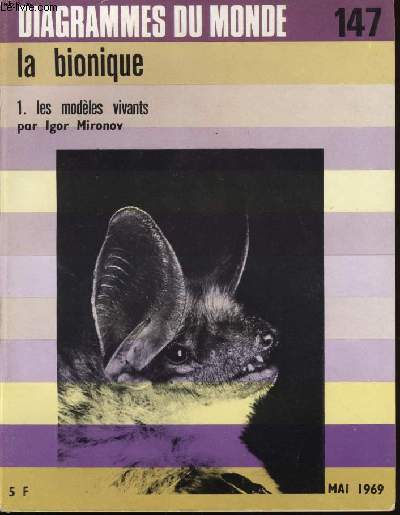The book was written in French by the Russian author I. Mironov was purchased at a bookstore in São Paulo which I often went to while still studying at the Polytechnic School in USP.


It was called the "Tecno Científica" bookstore, in a gallery on Barão de Itapetininga Street in São Paulo, despite being specialized in Russian books, it was tolerated by the military authorities of the government back then who "distrusted" everything that came from “communist” countries.
In fact, the bookstore sold only books, including calculus (Piskunov and Demidovitch), biology and mechanics books as well as many interesting scientific books, such as astronomy, and even bionics, such as the one I will deal with in this article.
Of course, because they were Russian authors, and the books financed by the government there, we could find certain “ideological pitfalls” in the middle of the texts.
But the important thing is that I. Mironov had a sensational and still very current view of Bionics and how it could be present in our lives now and in the future, as it already is.
It is noteworthy that the term Bionics is not new having first been used in 1958. At that time and in the subsequent years, the major concern of bionics was the replacement of human organs and the use of the solutions given by nature in the solution of several problems, mainly mechanical ones.
Thus, as Mironov himself says in his book, he graduated in mechanical engineering and to be able to "work" with bionics did a course in biology.
Nowadays we have the electronics at stake and together with the mechanics they seek to use solutions of these technologies to solve problems related to biology, that is, leading to bionics.
We believe that it is time for engineering schools to introduce the discipline of Bionics and also "biology for engineers" or "instrumental biology" as we already have other instrumental disciplines.
We quote as an example the "Instrumental English" or “technical English”, essential for today's engineers and technicians all over the world.
But what was spoken at the time and where does it apply today?
Bionics in 1970
Mironov attaches a lot of mechanics to biology, basically dealing with animal propulsion systems that can be used as examples for projects, sensors, with a special chapter for bats and dolphins which make use of sonars.
In mechanics he emphasizes the hydraulic propulsion of jellyfish that "pumps" water back to move forward and from the hydraulic system of the spider that jumps thanks to a "hypertension crisis" which pumps blood with force to distend the legs and with that it leads them to huge jumps.
An interesting highlight worthy of a current study is the fact that millions of bats fly simultaneously in some caves and do not collide despite all of them using the ultrasonic obstacle detection system.
How can you distinguish your own echo among thousands or even millions and position yourself so as to avoid collision with other nearby bats? Something to be studied today and applied to drones which should fly in crowds in the next few years.
The author also deals with the sensitivity of the smell of certain insects and the structure and sense organs of plants, a mystery at the time and that today we already find practical applications.
Current Bionics
In the 1970s, there was not an electronics as evolved as the current one, with the possibility of implanting chips in living organisms which could interact with us in a direct way.
This means that today's bionics, in addition to mechanics involving structural problems solved by nature and applied to several types of creatures, in addition to sensors, there must also be taken into account the electrical interactions, especially with the nervous system, to a much more intense degree .
Implantable chips, sensors, advanced mechanical and electrical solutions should be part of the studies of this science.
In a recent article we talk about the growing possibility of using waves emitted by the brain on the most diverse types of interaction with mechanical and other devices.
We already have the possibility to control circuits with certain types of brain waves produced voluntarily. We had the opportunity to try out such a circuit at IoT Latoin America in 2017 in São Paulo, developed by students from Fatec.
The discovery that when we talk to another person or other people, our brains can enter a certain state of attunement, communicating in a still unknown way, opens the way to a multitude of applications.
Ultimately, bionics are becoming indispensable to modern electronics applications and this must be taken into account.



